Feeding Romance: A German-Persian Wedding in Austria
Friday, 3 August 2007 by kinakoJam
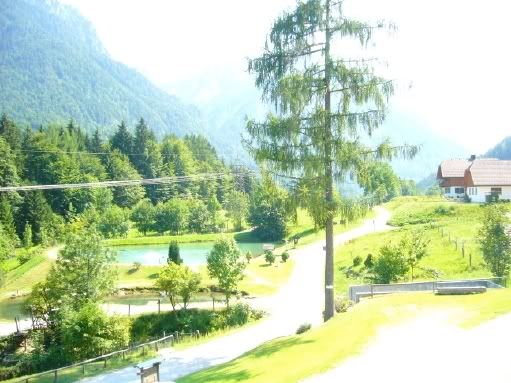
A couple weeks back, Many & Anne were wedded on the terrace of a beautiful wooden building with low hanging eaves, overlooking Wolfgangsee - one of those beautiful mountain lakes that were once the scene of infamous politician's debauchery, across the border from Germany. (This wedding was the reason for our 24 hour stopover in Munich, en route).
After the Protestant ceremony, there was a short break for 'sekt' (German bubbles):
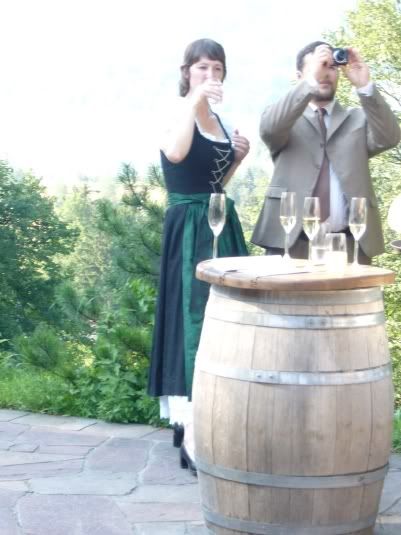
And then the Iranian ceremony began. It was one of the best wedding ceremonies I've seen, rich with symbolism and interspersed with a witty translation into English by the uncle from New York. And full of sweet stuff, quite literally.
The ceremony takes place with a beautiful and elaborately decorated spread on the floor called "Sofreh-ye Aghd". Traditionally Sofreh-ye Aghd is set on the floor facing east, the direction of sunrise (light). Consequently when bride and bridegroom are seated at the head of Sofreh-ye Aghd they will be facing "The Light".
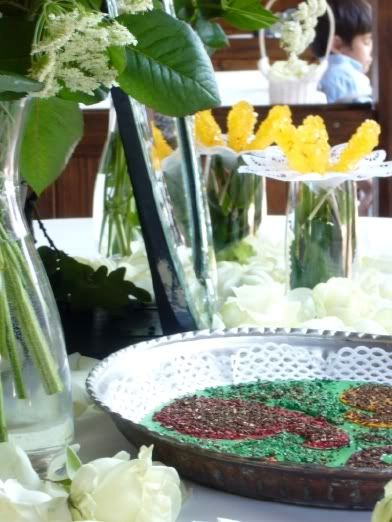
On Sofreh-ye Aghd, the following items are placed:
Mirror (of fate) "Aayeneh-ye Bakht" and two Candelabras (representing the bride and groom and brightness in their future) one on either side of the mirror. The mirror and two candelabras are symbols of light and fire, two very important elements in the Zoroastrian culture. When the bride enters the room she has her veil covering her face. Once the bride sits beside the bridegroom she removes her veil and the first thing that the bridegroom sees in the mirror should be the reflection of his wife-to-be.
A tray of seven multi-colored herbs and spices "Sini-ye Aatel-O-Baatel" to guard the couple and their lives together against the evil eye, witchcraft and to drive away evil spirits. This tray consists of seven elements in seven colors:
Poppy Seeds "Khash-Khaash" (to break spells and witchcraft)
Wild Rice "Berenj"
Angelica "Sabzi Khoshk"
Salt "Namak" (to blind the evil eye)
Nigella Seeds "Raziyaneh"
Black Tea "Chaay"
Frankincense "Kondor" (to burn the evil spirits)
A specially baked and decorated flatbread "Noon-e Sangak" with blessing "Mobaarak-Baad" written in calligraphy on it. The writing is usually with either saffron "Zaffaron", cinnamon, Nigella seeds, or glitters. This symbolizes prosperity for the feasts and for the couple's life thereafter. A separate platter of this flat bread, feta cheese and fresh herbs are also present to be shared with the guests after the ceremony, to bring the new couple happiness and prosperity.
A basket of decorated eggs and a basket of decorated almonds, walnuts and hazelnuts in the shell to symbolize fertility.
A basket of pomegranates and/or apples for a joyous future. Pomegranates are considered heavenly fruits and apples symbolize the divine creation of mankind.
A cup of rose water extracted from special Persian roses "Gol-e Mohammadi" to perfume the air.
A bowl made out of crystallized sugar "Kaas-e Nabaat/Shaakh-e Nabaat" to sweeten life for the newly wed.
A scarf or shawl made out of silk or any other fine fabric is held over the bride and bridegroom's head throughout the ceremony by various happily married female relatives (mostly bride's close family members). It looks so pretty.
Two sugar cones "Kalleh Ghand" made out of hardened sugar are used during the ceremony. These sugar cones are ground together above the bride and bridegroom's head (over the scarf held above their heads) throughout the ceremony to shower them in sugar (symbolizing sweetness and happiness). Many's aunt did the grinding, she is a jewellery expert and dynamite on the dancefloor.

A cup of honey is used symbolically to sweeten life. Immediately after the couple is married they each should dip one pinky finger in the cup of honey and feed it to the other one. This part was very cute. Below you see them exchanging rings, just before pinky-dipping:

A needle and seven strands of colored thread to figuratively sew up the mother-in-law's lips from speaking unpleasant words to the bride! The shawl that is held above the couple's head throughout the ceremony is sewed in one corner by the needle and threads.
After the preliminary blessings and a few words about the importance of the institution of marriage, the master of ceremony confirms with both the parents or guardians that they indeed wish to proceed with the ceremony and there are no objections. Then the master of ceremony asks the mutual consent of the couple. First the bridegroom is asked if he wishes to enter into the marriage contract, then the bride is asked the same question. Once the bride is asked if she agrees to the marriage, she pauses. The question is repeated three times and it is only at the third time that she will say yes. To make the bridegroom wait for the bride's answer is to signify that it is the husband who seeks the wife and is eager to have her and not the other way around!
Traditionally after the ceremony while the bride and groom are still seated the bride is showered with gifts, usually expensive jewelry, and all she receives is hers. The bridegroom does not receive many gifts. He only receives one gift from the bride's parents/guardians. When all the gifts are presented to the bride the wedding ceremony is officially concluded.
A copy of Koran "Ghoraan-e Majid" (the Moslem's holy book) opened in the middle and placed on the spread. This symbolizes God's blessing for the couple. Traditionally "Avesta" the ancient Zoroastrian holy book was present during the ceremony and readings were made from it. Eventually Koran replaced Avesta after Iran became a Moslem nation.
There were an assortment of sweets and pastries shared with guests after the ceremony. The assortment usually includes: Sugar coated almond strips "Noghl", Baklava (a sweet flaky Persian pastry "Baaghlavaa"), Mulberry-almond paste made in the shape of mulberries "Tout", Rice-flour cookies "Noon-Berenji", Chickpea-flour cookies "Noon-Nokhodchi", Almond-flour cookies "Noon-Baadoomi", and Honey roasted almonds "Sohaan A'sali".
Delicious powdery perfumed cookies:
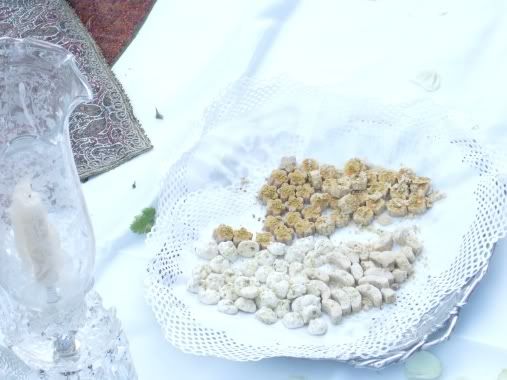
Mother of the groom, lips intact:
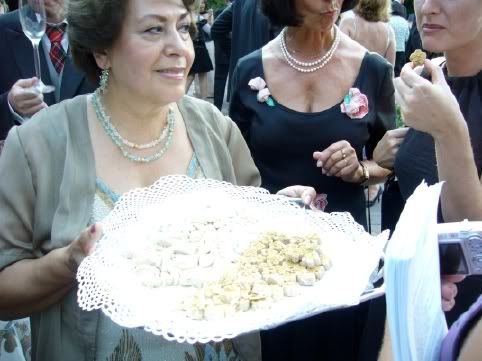
Caramel, pistachio & almond clusters:
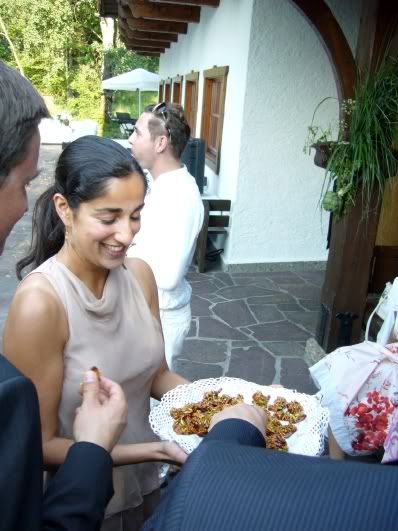
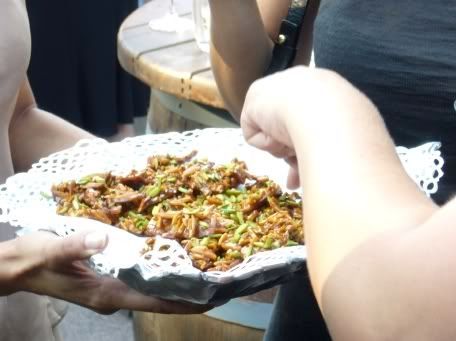
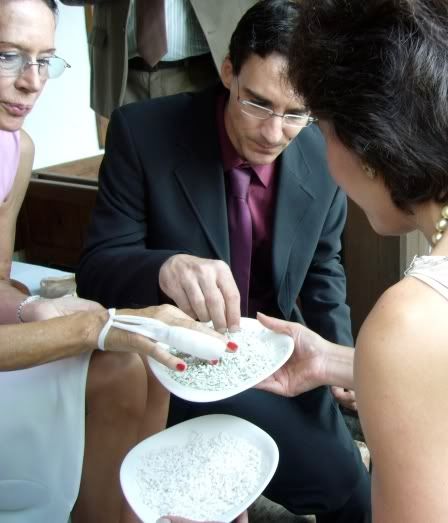
Baaghlavaa:
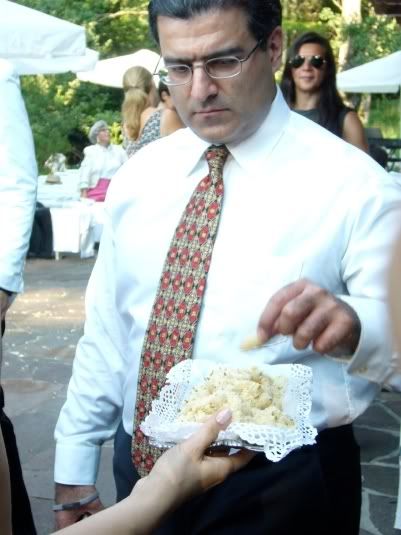
Mini lederhosen:

Before they enter their home, the bride kicks over a bowl of water placed in the doorway. The water spilled on the threshold represents enlightenment, happiness, and purification for their new house. A friendly competition starts with the bride and groom as the bride tries to enter her house while stepping on her husband's feet. This act makes the bride the boss in the household.

wow so lovely, a little jealous, I think there is something to be said for tradition and romance
Girl you be goin off!
True love be goin' off...
I'm not ashamed to admit that looking at those pics of Many &Anne (and you guys' wedding in Yokohama) brings a tear to my eye!
Thank you for sharing information. It is quite useful for us also. I always love to read such type of things. Costa Rica Cheap Land for Sale